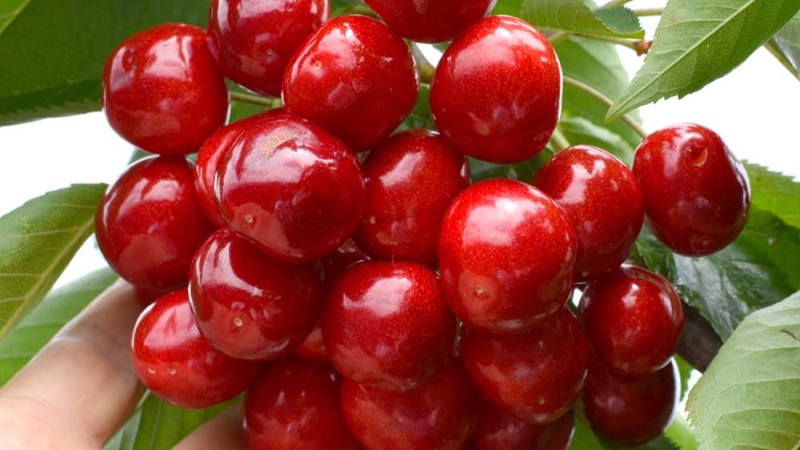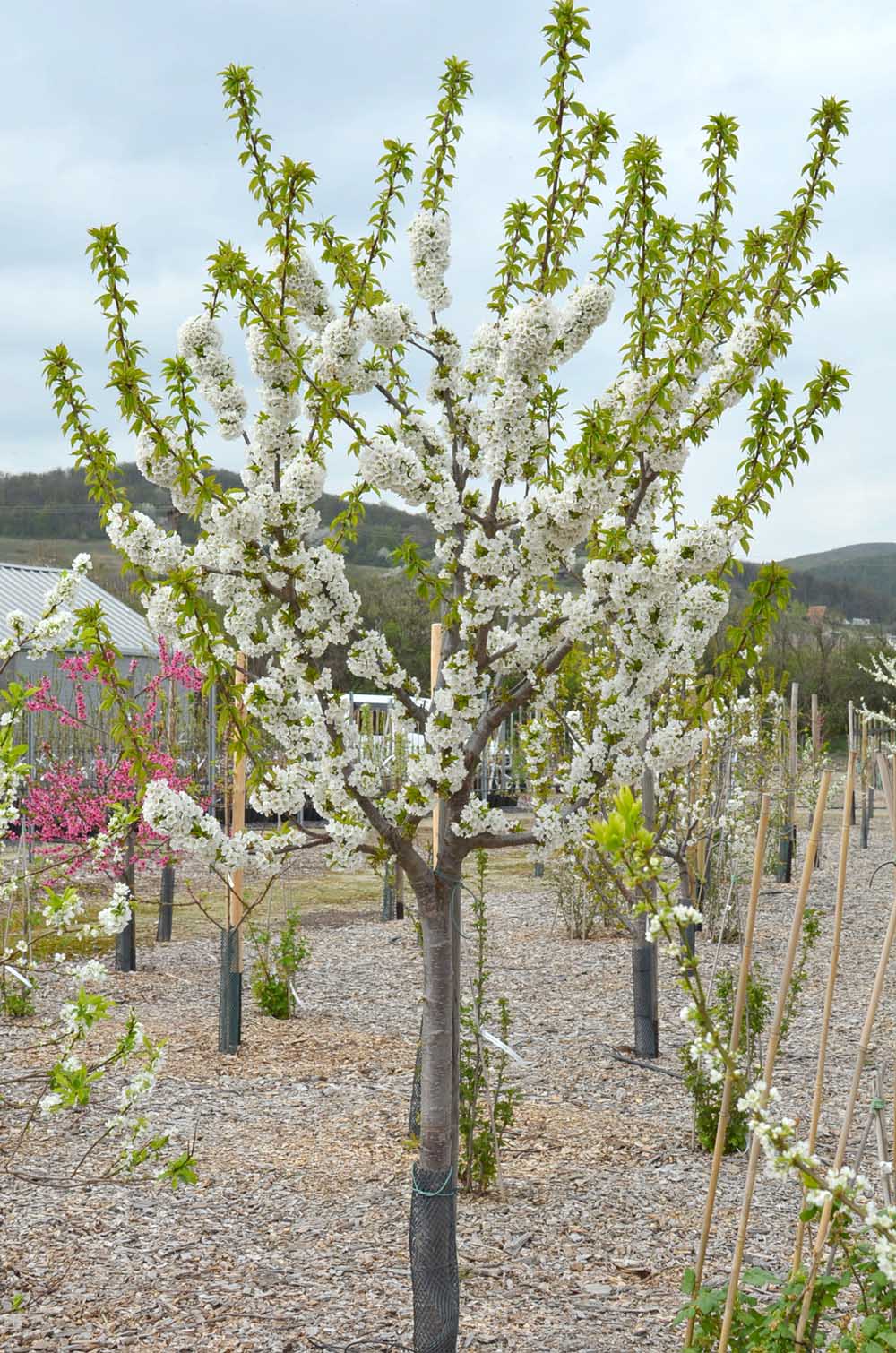

To je dobrá správa pre všetkých milovníkov čerešní s malou záhradou. Je to zásluha tímu nemeckých šľachtiteľov z Ústavu rastlinnej výroby a šľachtenia rastlín na Univerzite v Gießene, ktorý vyšľachtil sériu čerešňových podpníkov GiSelA. Tieto podpníky redukujú rast naštepenej odrody tak, že strom dosiahne len zlomok veľkosti oproti čerešni naštepenej na vtáčnici a ľahko sa udržiava. Z tejto série sa stal najpoužívanejším slaborastúci podpník GiSelA 5. Je kompatibilný so všetkými súčasnými odrodami čerešní a veľkou výhodou je, že odrody naštepené na podpník GiSelA 5 kvitnú a prinášajú ovocie už v druhom roku po výsadbe. Už vo štvrtom roku po výsadbe môžete očakávať úrodu približne 5 kg čerešní. Strom čerešne štepený na vtáčnici začína plodiť oveľa neskôr, významnejšie úrody prinesie až vo veku 6 až 10 rokov.
Čerešni sa darí v rôznych typoch pôd, okrem ťažkých a zamokrených. Strom potrebuje slnečné a vzdušné stanovište. Kvety čerešní sú citlivé na mráz, preto sa vyhýbajte oblastiam s častými neskorými mrazmi. Čerešňa na podpníku GiSelA 5 vyžaduje minimálny priestor 10 m² (čo zodpovedá priemeru koruny asi 3 m). Aby ste zabezpečili dostatočný prísun vody pre mladý stromček, udržiavajte pôdu pod korunou bez buriny a v prvom roku zavlažujte vždy počas suchých období. V závislosti od kvality pôdy, aplikujte každoročne 30g NPK hnojiva na m² na začiatku vegetácie a rovnaké množstvo po odkvitnutí. Hnojivo treba rozhodiť po celej ploche pod korunou.
Rez čerešne na slaborastúcom podpníku GiSelA 5
Čas rezu
Čerešne je možné rezať od pučania až do obdobia 2 mesiace po zbere. Silne rastúce stromy je najlepšie rezať po zbere, lebo takto zvoleným termínom rezu sa dá znížiť sila rastu čerešne. Jarný rez naopak podporuje silu rastu. Ak čerešňa rastie v oblasti s častým výskytom glejotoku, lepší je letný rez v období suchej periódy, kedy je nebezpečenstvo infekcie minimálne.
Tvarovací rez
V prvých rokoch po výsadbe je nevyhnutné venovať pozornosť základnému tvarovaciemu rezu, prostredníctvom ktorého sa dá dosiahnuť požadovaný tvar koruny. Obdobie tvarovacieho rezu u čerešní na podpníku GiSelA 5 trvá 2-4 roky, teda obdobie keď strom nedosahuje plný rodivý potenciál. Existuje niekoľko systémov tvarovacieho rezu. V nasledujúcej časti si popíšeme základné princípy jedného z nich, ktorý bez problémov zvládnu aj záhradkári. Cieľom tohto rezu je, podľa potreby širšia alebo užšia kónická koruna, so stredníkom a bočnými pravidelne rozmiestnenými vetvami s plodonosným obrastom.
Prvé vegetačné obdobie
Predpokladajme že začíname s tvarovacím rezom u jednoročného očkovanca, bez bočného vetvenia. Tesne po vypučaní vyslepte 5-6 púčikov tesne pod terminálnym púčikom. V nasledujúcom období z ponechaných púčikov začnú vyrastať bočné výhony. Z nich vyberte 3-5 a to také, ktoré sú pravidelne rozmiestnené čo do výšky a smeru do priestoru. Je to dôležité, pretože v budúcnosti bude rozmiestnenie týchto vetví rozhodovať o množstve svetla a prevzdušnení koruny.
Druhé a tretie vegetačné obdobie
Budúce bočné plodonosné vetvy ktoré narástli v predchádzajúcom roku sa v čase pučania zrežú na polovicu dĺžky. Ale majte na pamäti, že posledný zostávajúci púčik vždy smeruje von z koruny. V lete sa bočné výhony vzrastajúce z vrchnej časti koruny skracujú za 4-6 listom. Nerozvetvené bočné výhony v strednej a spodnej časti koruny je treba tiež skrátiť, aby sa dobre rozvetvili. Dávajte pritom pozor na dodržanie kónického tvaru koruny.
Štvrté a piate vegetačné obdobie
V tomto období môžete dokončiť základný tvarovací rez podobným postupom ako v predošlých rokoch. Strom teraz vstupuje do fázy pravidelnej plnej rodivosti. Odteraz už musí byť rast regulovaný pravidelným udržiavacím rezom, aby strom prinášal pravidelnú vysokú a kvalitnú úrodu. Ak je čerešňa na GiSelA 5 ponechaná bez udržiavacieho rezu, výsledkom bude vyholené plodonosné drevo, a menšie plody. Okrem toho rezom presvetlíte a prevzdušníte korunu a udržiavate potrebnú výšku stromu aj tvar koruny.
Udržiavací rez
Udržiavací rez je nutné začať, keď je prírastok letorastov predchádzajúcom roku menší ako 30 cm. Tu sú základné pravidlá:
- odstráňte choré, odumreté a slabé výhony
- bočné hlavné vetvy je nutné skrátiť v priemere o 1/3 dĺžky, a to horné viac a spodné menej. Sleduje sa tým udržanie kónického tvaru koruny, ktorý je najvhodnejší pre optimálne presvetlenie celej koruny, teda aj spodnej časti.
- ak bočná vetva smeruje nadol, snažte sa ju spätným rezom dostať späť do vodorovnej polohy. Postupujte tak, že odrežete vetvu až po nasledujúci bočný, nahor smerujúci výhon.
- ak strom dosiahol maximálnu, vami požadovanú výšku, vrchol zrežte po nasledujúci slabší bočný výhon. Najlepší termín je po zbere. Tento postup môže byť zopakovaný v nasledujúcich rokoch. Vďaka tomu že strom rastie na podpníku GiSelA 5, na túto procedúru nereaguje vytvorením silných výhonov vo vrcholovej časti. Preto môže byť udržiavaný v maximálnej a stabilnej výške 3,5 m.
- občas, teda nie každý rok odrežte jeden z bočných plodonosných výhonov celý, až po hlavnú os. Množstvo svetla v korune prebudí vytvorenie nového bočného výhonu s bohatým plodonosným obrastom.
- ďalším odporúčaním je spätný rez slaborastúcich jednoročných výhonov až do starého dreva, v súlade s pravidlom: čím slabší je rast, tým silnejší je rez









